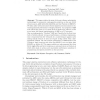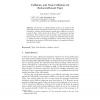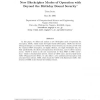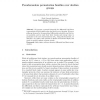FSE
2006
Springer
13 years 8 months ago
2006
Springer
This paper studies the state-of-the-art software optimization methodology for symmetric cryptographic primitives on the new 64-bit x64 processors, AMD Athlon64 (AMD64) and Intel Pe...
FSE
2006
Springer
13 years 8 months ago
2006
Springer
We describe a collision-finding attack on 16 rounds of the Tiger hash function requiring the time for about 244 compression function invocations. Another attack generates pseudo-ne...
FSE
2006
Springer
13 years 8 months ago
2006
Springer
We present several attacks against Achterbahn, one of the new stream ciphers proposed to the eSTREAM competition. Our best attack breaks the reduced version of the cipher with comp...
FSE
2006
Springer
13 years 8 months ago
2006
Springer
In this paper, we define and analyze a new blockcipher mode of operation for encryption, CENC, which stands for Cipher-based ENCryption. CENC has the following advantages: (1) bey...
FSE
2006
Springer
13 years 8 months ago
2006
Springer
FSE
2006
Springer
13 years 8 months ago
2006
Springer
We propose a general framework for differential and linear cryptanalysis of block ciphers when the block is not a bitstring. We prove piling-up lemmas for the generalized different...
FSE
2006
Springer
13 years 8 months ago
2006
Springer
The purpose of algebraic attacks on stream and block ciphers is to recover the secret key by solving an overdefined system of multivariate algebraic equations. They become very eff...
FSE
2006
Springer
13 years 8 months ago
2006
Springer
We present PEP, which is a new construction of a tweakable strong pseudo-random permutation. PEP uses a hash-encrypt-hash approach which has recently been used in the construction...
FSE
2006
Springer
13 years 8 months ago
2006
Springer
MD5 is a well-known and widely-used cryptographic hash function. It has received renewed attention from researchers subsequent to the recent announcement of collisions found by Wa...
FSE
2006
Springer
13 years 8 months ago
2006
Springer
The Ideal-Cipher Model of a blockcipher is a well-known and widely-used model dating back to Shannon [24] and has seen frequent use in proving the security of various cryptographi...




